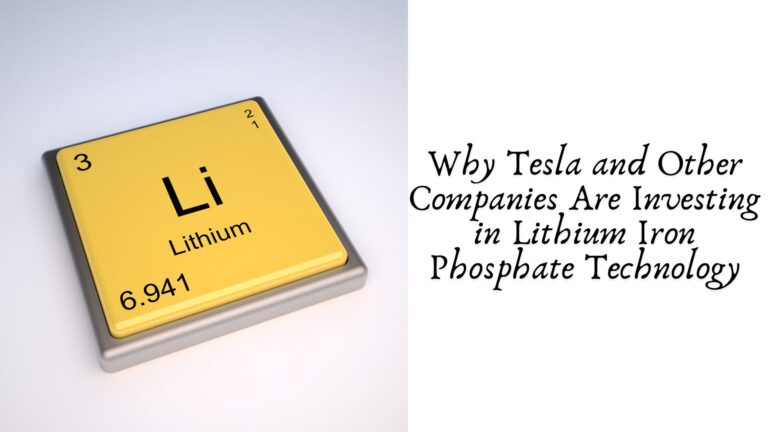Introduction
As the demand for electric vehicles (EVs) and energy storage solutions grows exponentially, companies like Tesla are making significant investments in lithium iron phosphate (LFP) battery technology. While lithium-ion batteries have dominated the market for years, LFP technology is gaining traction due to its safety, cost-effectiveness, and longevity. This article explores the reasons behind the shift to LFP technology and its implications for the future of energy storage and EVs.
The Rise of LFP Batteries
Lithium iron phosphate (LiFePO4 or LFP) batteries are a subtype of lithium-ion batteries that use iron phosphate as the cathode material. Unlike nickel-manganese-cobalt (NMC) and nickel-cobalt-aluminum (NCA) batteries, LFP batteries do not rely on expensive and scarce materials such as cobalt and nickel. Instead, they use iron, which is abundant and less environmentally damaging to extract.
Tesla, along with other major automakers like BYD and Ford, has recognized the benefits of LFP technology and is incorporating these batteries into their EV models. The shift is particularly evident in Tesla’s standard-range vehicles, where LFP batteries offer a more sustainable and cost-effective alternative.
Advantages of LFP Battery Technology
Cost-Effectiveness
One of the primary reasons companies are investing in LFP batteries is their lower cost. Cobalt and nickel, key components in traditional lithium-ion batteries, are expensive and subject to volatile price fluctuations. LFP batteries eliminate the need for these materials, resulting in a more stable and affordable supply chain.
Enhanced Safety
LFP batteries are significantly safer than NMC and NCA batteries. They are less prone to overheating and thermal runaway, reducing the risk of fires and explosions. This enhanced safety makes them particularly attractive for EVs and large-scale energy storage systems.
Longer Cycle Life
Compared to other lithium-ion batteries, LFP batteries have a longer cycle life. They can endure up to 4,000 charge-discharge cycles, whereas NMC and NCA batteries typically last between 1,000 and 2,000 cycles. This durability translates to a longer lifespan for EVs and energy storage systems, reducing the need for frequent battery replacements.
Improved Sustainability
The environmental impact of battery production is a growing concern. The mining of cobalt and nickel is linked to ethical and ecological issues, including habitat destruction and labor exploitation. By shifting to LFP technology, companies can minimize their environmental footprint and promote more sustainable practices.
Faster Charging Capabilities
LFP batteries can be charged more quickly than their NMC counterparts without significant degradation. This makes them ideal for commercial fleets, where rapid charging is essential for maintaining operational efficiency.
Tesla’s Commitment to LFP Technology
Tesla has been a pioneer in advancing LFP battery technology. The company has incorporated LFP batteries into its standard-range Model 3 and Model Y vehicles, particularly in the Chinese and European markets. Additionally, Tesla has secured partnerships with leading LFP battery manufacturers, such as CATL (Contemporary Amperex Technology Co. Limited), to ensure a steady supply of these batteries.
Elon Musk has publicly endorsed LFP technology, emphasizing its advantages in safety and longevity. The company’s Gigafactories are also adapting production lines to accommodate LFP battery manufacturing, reflecting a long-term commitment to this technology.
Other Companies Following Suit
Tesla is not alone in its investment in LFP batteries. Several other companies are embracing the technology:
- BYD: The Chinese automaker has developed its own LFP-based Blade Battery, which offers exceptional safety and longevity.
- Ford: The company has announced plans to integrate LFP batteries into some of its EV models to provide cost-effective alternatives to traditional lithium-ion batteries.
- Volkswagen: The German automaker is also exploring LFP technology for its entry-level EVs, aiming to make electric mobility more affordable.
- Energy Storage Firms: Companies specializing in grid-scale energy storage, such as Fluence and Tesla’s Megapack division, are increasingly turning to LFP batteries due to their durability and stability.
Challenges and Limitations
Despite its numerous benefits, LFP technology is not without its challenges:
- Lower Energy Density: LFP batteries generally have a lower energy density compared to NMC and NCA batteries, meaning they store less energy per unit of weight. This can impact the range of EVs, making them less suitable for long-distance travel.
- Cold Weather Performance: LFP batteries tend to underperform in extremely cold temperatures, which could be a concern for regions with harsh winters.
- Market Adaptation: While adoption is increasing, transitioning manufacturing processes to LFP technology requires significant investment and retooling.
The Future of LFP Technology
With continuous research and development, many of LFP’s current limitations are being addressed. Advancements in battery chemistry and engineering are improving energy density and cold-weather performance. Additionally, as EV infrastructure expands and charging networks improve, the slightly lower range of LFP batteries will become less of a drawback.
The global shift toward sustainable energy solutions ensures that LFP technology will play a crucial role in the future of EVs and energy storage. Companies investing in LFP batteries today are positioning themselves for long-term success in an increasingly electrified world.
Conclusion
Tesla and other leading companies are investing heavily in lithium iron phosphate technology due to its cost-effectiveness, safety, longevity, and sustainability. While challenges remain, the rapid advancements in LFP battery development indicate a promising future. As the world moves towards cleaner and more efficient energy solutions, LFP batteries are set to play a pivotal role in shaping the next generation of electric mobility and energy storage systems.
